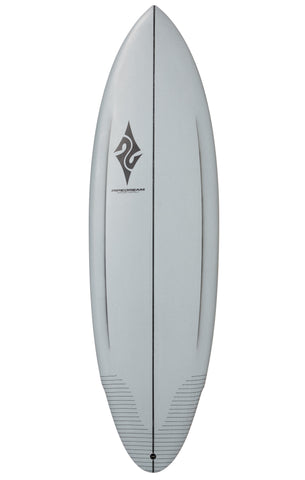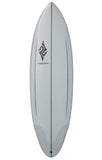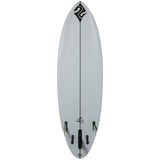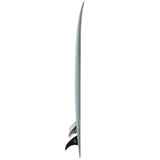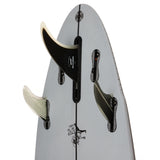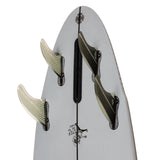The PU STEP 123
The thought behind this model came primarily to address the paddle crisis for those who need to keep their boards short…and indeed there are many of us...! In addition, the inclusion of multipurpose options into the one board, but sensibly. Firstly, the inclusion of the step deck is for those obsessed with keeping short, and who have only width and thickness to buy back some of the lost paddle by staying short. Too much width puts pressure on thruster mode and too much thickness corks the board out for all modes making it difficult to throw around on rail.
The thickness dilemma can be minimized by rolling the deck more, but there is a limit to that before you feel like you are on a cockatoo’s perch. The step deck allows you to go way thicker on the stringer still retaining only a subtle roll, but with a rail that penetrates since it is way thinner due to the scalloped step. The rail penetration issue is also alleviated by the step as well when you are pushing width limits to help the paddle issue.
The inclusion of 3 different fin set options is off the back of our understanding of what now can be shared and not shared in one particular board with fin choices and their positions. This board design is indeed 3 boards in one without compromise, well perhaps a small compromise in thruster mode, but only a little. So, for those who have finally given up the notion of winning a world title and happy to surf to their ability this board will put 3 springs back in your step.
PLAN SHAPE
The plan shape on the Step 123 is of course widish due to the paddle reasons mentioned above, but more importantly wider up front making it feel at home in quad or 2+1 mode. In thruster mode however too much nose width or too much width in general does not suit the pivot and thrust motion they were designed for, but with the inclusion of an 8” fin box the centre thruster fin be it a tad larger than the side fins will hold and can be adjusted position wise for different size waves. With that centre fin slightly further up the wider nose does not feel so far away particularly when keeping short. Also, to encourage bight the narrowing of the tail using a wing and the low razor-sharp rails particularly designed into the last ¼ at the tail end gives it the extra bight it may need at speed with the centre fin intentionally further forward in thruster mode.
BOTTOM SHAPE
The bottom shape is identical to the Twinzaa in that it sports the cathedral hull in the nose which is a very important component for paddle when keeping short. Moving through to a shallow single concave through the guts transforming into a lengthy tail vee exiting the tail. It’s like tail vees are now coming back because they give you more heel to toe leverage in wider tails without loss of bight or speed due to the extra fin persuasions.
ROCKER
Again the rocker is identical to the Twinzaa in that it has quite a low nose entry facilitated by the lifting action of the hull which again gives this design superior paddle whilst remaining short. On the other hand there is more generous lift provided to the tail in order to keep all fin options on the looser side.
FIN SETTINGS
Ok buckle yourself in coz there is a bit in this. It is a known fact that thrusters come from the single fin family and quads come from the Twin fin family and the struggle designers have had with making 5 finned boards with thruster and quad options-is the nose widths and width in general. As we know thrusters are width sensitive- quads and twin fins are not since they have no centre fin to nurse through turns. So, most of those plan shapes in 5 finners are only a safe compromise. In this case in order to obtain a lot of extra paddle in the Step 123 without increasing length- there is no compromise with width. It had to stay!
Thruster mode is not a problem in wide tails in small waves but in mid-size or bigger with the rear fin an inch or so further forward ( since a box will not allow going back any further due to finer tail foils) it needs to be slightly deeper than the sides for holding purposes. The side fins have also been moved forward to keep the thruster cluster honest, but it so happens this position also suits the side bight position when in 2+1 mode as they need to be further forward as well. Additionally quad fin positions can be moved forward without any tail slide so this also suits quad mode and in general a footing position more forward than most designs to help deal with the wider nose and thus increasing leverage rail to rail. One may ask why not include a twin fin mode, but the front side fins are way too forward for a twin fin feel to be successful- so a Step 1234 would be a leap of faith in my opinion...!
LAMINATING
The standard glass job for the S123 is a diagonal 4x4x4 with toe patch on the rear deck and a fin patch all around the fin clusters on the bottom to help anchor all the fin boxes.
All boards have to be made upon order. This means that add ons can be customized in to suit. Ring Muzz 0421 385 692
DIMS
6.0 x 20 5/8 x 2 7/8 = 36.48 lts
6.2 x 20 7/8 x 2 15/16 = 38.9 lts
6.4 x 21 1/8 x 2 15/16 = 40.4 lts
6.6 x 21 3/8 x 2 15/16 = 41.96 lts

